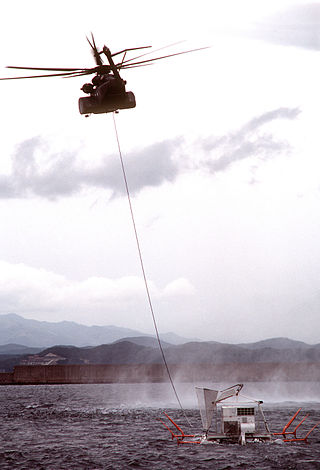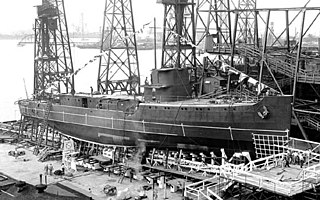
A minesweeper is a small warship designed to remove or detonate naval mines. Using various mechanisms intended to counter the threat posed by naval mines, minesweepers keep waterways clear for safe shipping.

USS Chandler (DD-206/DMS-9/AG-108) was a Clemson-class destroyer in the United States Navy. She was the only ship named for William Eaton Chandler, who served as Secretary of the Navy from 1882 to 1886.

Minesweeping is the practice of removing explosive naval mines, usually by a specially designed ship called a minesweeper using various measures to either capture or detonate the mines, but sometimes also with an aircraft made for that purpose. Minesweeping has been practiced since the advent of naval mining in 1855 during the Crimean War. The first minesweepers date to that war and consisted of British rowboats trailing grapnels to snag the mines.

The Ton class were coastal minesweepers built in the 1950s for the Royal Navy, but also used by other navies such as the South African Navy and the Royal Australian Navy. They were intended to meet the threat of seabed mines laid in shallow coastal waters, rivers, ports and harbours, a task for which the existing ocean-going minesweepers of the Algerine class were not suited.
HMS Bassingham was one of 93 ships of the Ham class of inshore minesweepers, of which HMS Inglesham was the first. Their names were all chosen from villages ending in -ham. The minesweeper was named after Bassingham in Lincolnshire. She was built by Vospers Ltd. of Portsmouth, which later became Vosper-Thorneycroft and was commissioned in October 1953. She displaced 164 tons fully laden and was armed with one 40 mm Bofors gun.
HMS LST 3002 was one of the first of her class of tank landing ship (LST). She had a short but interesting career which demonstrated the robustness of the design and construction of her class of ship.

HMS Abbotsham was one of 93 ships of the Ham class of inshore minesweepers.
HMS Etchingham was one of 93 ships of the Ham-class of inshore minesweepers.

HMS Greetham was one of 93 ships of the Ham class of inshore minesweepers. All ships in this class had names chosen from villages ending in -ham. The minesweeper was built by the firm of Herd & McKenzie in Buckie, Moray and was named after Greetham, Lincolnshire. Entering service in 1955, the vessel was transferred to the Libyan Navy in 1962 on loan and permanently in 1966. Renamed Zuara, the minesweeper was used as a patrol vessel until 1973. Zuara was sold to Captain Morgan Cruises of Malta for commercial use and renamed Lady Davinia. The ship was taken out of service in 2007 and laid up at Sliema Creek. Lady Davinia sank at her moorings in 2008 and for a short time became a diving attraction but in 2011 the wreck was partially broken up after being named a navigational hazard.
HMS Mersham was a Ham-class minesweeper of the Royal Navy. All ships of the class were named after villages ending in -ham. The minesweeper was named after Mersham in Kent. Constructed at Appledore, in Devon, Mersham was launched in April 1954 and completed in January 1955. In April 1955, the ship was transferred to the French Navy and in French service, was known by its pennant number, M773, until it was renamed Violette in 1964. Throughout the 1950s and early 1960s, the vessel undertook minesweeping duties from Brest in Brittany, before being laid up in 1965. In 1974, the ship was transferred to the Gendarmerie and undertook patrol duties until finally being decommissioned in 1987.
HMS Petersham was a Ham-class minesweeper of the Royal Navy.

HMS Portisham was one of 93 ships of the Ham-class of inshore minesweepers.
HMS Shrivenham was one of 93 ships of the Ham-class of inshore minesweepers.

USS Auk (AM-57) was an Auk-class minesweeper acquired by the United States Navy for the dangerous task of removing mines from minefields laid in the water to prevent ships from passing.
HMS Abingdon was a Hunt-class minesweeper of the Aberdare sub-class built for the Royal Navy during World War I.

USS Tide (AM-125) was an oceangoing Auk class minesweeper built for the United States Navy during World War II. Named for the marine tide, she was the only U.S. Naval vessel to bear the name.
USS Staunch (AM-307) was a steel-hulled Admirable-class minesweeper built for the U.S. Navy during World War II. Her crew was quickly trained in the art of minesweeping and then sent to the Pacific Ocean to clear dangerous mine fields so that Allied troops could land on Japanese-held beaches. Because of her courageous work under fire, she was awarded four battle stars.
USS Spectacle (AM-305) was a steel-hulled Admirable class minesweeper built for the U.S. Navy during World War II. A trained crew boarded the new vessel, practiced with her minesweeping gear, and then proceeded to the Pacific Ocean to clear mines from Japanese beaches so that Allied forces could invade. While performing this dangerous task of mine clearance, a Japanese plane strafed her, and another deliberately crashed into her. When she returned to the United States, her battle damage was so severe that the U.S. Navy decided to scrap, rather than to repair, her. She was awarded two battle stars.

HMS Manxman (M70) was an Abdiel-class minelayer of the Royal Navy. The ship is named for an inhabitant of the Isle of Man. It served in the Mediterranean during World War II, and entered the Reserve Fleet following the end of the war.

HMAS Goorangai was a 223-ton auxiliary minesweeper of the Royal Australian Navy (RAN). She was built in 1919 for the Government of New South Wales, then sold in 1926 to the fishing company Cam & Sons. The trawler was requisitioned for military service following the outbreak of World War II, converted into a minesweeper, and assigned to Melbourne. She was sunk in an accidental collision with MV Duntroon in 1940, becoming the RAN's first loss of World War II, and the first RAN surface ship to be lost in wartime.









